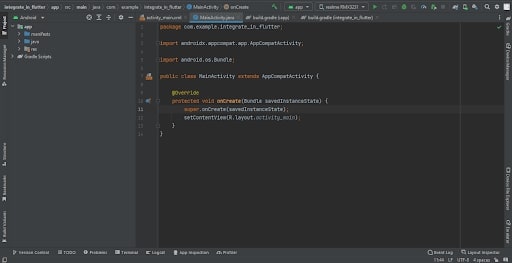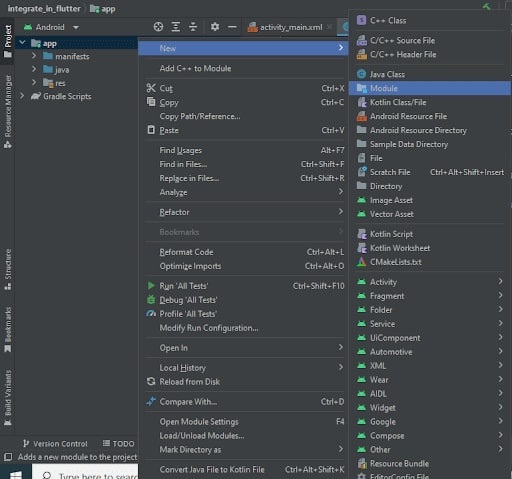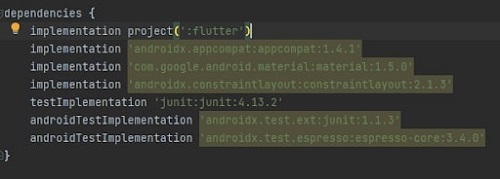Adding or integrating Flutter into existing android apps is a must be needed when you are in the modern world where cross platforms apps are booming. However, it requires a specific solution for your app. Thus, it should be arranged with a proper solution and do existing Android apps. In another way, this is called migrating your existing android app into Flutter. This will be a single platform to cross-platform migration as Flutter is the cross-platform framework.
Flutter furnishes us with a stage to create custom applications for Android and iOS. Utilizing the Flutter app, we can coordinate modules of our Flutter project into any current local ventures. After coordinating the Flutter project, we can foster the remainder of the Shudder application, which will be naturally reflected in the parent projects.
Add Flutter to a current Android application
Of course, Flutter permits us to do a couple of things previously incorporated into Android applications, which are made sense of beneath. This module fabricates wizard permits co-altering Android ventures and Flutter projects in our Android Studio. It upholds two sorts of applications like Kotlin and Java.
Whenever we have coordinated Flutter, you can likewise utilize shutter join to the ID to associate it with the application. It can coordinate and adjust to the modules in Flutter, and the Flutter modules can be coordinated consistently.
When we add the shudder SDK snares in our Gradle record, it auto-constructs the Flutter modules we have made. What’s more, it permits significant Shudder modules to coordinate and adjust to the prior stage and how Flutter modules can then be flawlessly incorporated accordingly.
Code and Implement
Flutter gives Flutter. Activity is inside the android application that reenacts the shudder insight. We want to enroll Flutter action in AndroidManifest.xml. You want to carry it out in your code separately:
In the first place, we add Action. Primary. A button has been made in XML in which the name and ID of the button have been given, which will assist us with playing out any activity on the button.
Then, we will characterize the android action inside button in the primary movement class, which coordinates the Flutter project inside our android application; it keeps up with its liabilities like showing the sprinkle screen of android and Flutter. As the code underneath is given in the reference, Flutter will easily do existing things and manage them.
Flutter can be installed into your current Android application piecemeal, as a source code Gradle subproject or as AARs. The combination stream should be possible using the Android Studio IDE with the Shudder module or physically.
Utilizing Android Studio
The Android Studio IDE is a helpful approach to incorporating your Flutter module. With Android Studio, you can co-alter your Android and Shudder code in a similar task. You can likewise keep on utilizing your ordinary IntelliJ Flutter module functionalities, for example, Dart code finish, hot reload, and gadget auditor.
Add-to-application streams with Android Studio are just upheld on Android Studio 3.6 with variant 42+ of the Shudder module for IntelliJ. The Android Studio combination likewise just backings coordinating utilizing a source code Gradle subproject, as opposed to utilizing AARs. See beneath for additional subtleties on the qualification.
Utilizing the Record > New > New Module… menu in Android Studio in your current Android project, you can make another Flutter module to coordinate or select a current Shudder module that was made beforehand.
Also, Read This Post:
Building Android Widgets In Flutter: Remember these Simple Points
Manual reconciliation
To coordinate a Flutter module with a current Android application physically, without utilizing Flutter’s Android Studio module, follow these means:
Add the android module as a Flutter app
Then, add the Shudder module as relies on your current application in Gradle. There are two methods for accomplishing this. The Flutter app integrating tools makes nonexclusive Android AARs go-betweens that bundle your Flutter module.
This is great when your downstream application developers would rather not have the Flutter SDK introduced. In any case, it adds another form step assuming you construct much of the time.
The source code subproject component is a helpful single-tick fabricating process; however, it requires the Flutter SDK. This is the system utilized by the Android Studio IDE module. Following the fundamental stages beneath, you can add Flutter to your Android and iOS applications. We should begin with the Android application!
Also, Read This Post:
Flutter vs. Kotlin:Which framework to select for your next development project
Adding Flutter to Android Application
- Create a new android project

- Add new flutter module to your application

OR you can add from terminal Flutter create -t module name_of_module

- Add a dependency to the app-level build.gradle of the host app.

Auto-construct and import the Shudder module by adding a Flutter SDK snare to your Gradle script.
Incorporate your Flutter module into a conventional Android Document (AAR) for reconciliation into your form framework and for better Jetifier interoperability with AndroidX.
Flutter Engine Programming interfaces for freely beginning and persevering your Shudder climate by connecting a FlutterActivity/FlutterFragment and so on.
Android Studio Android/Flutter co-altering and module creation/import wizard
Flutter modules can utilize Shudder modules to collaborate with the stage
Our native Android project has now been successfully merged with Flutter.
Wrapping Up
We made it easy to understand integrating Flutter into existing android apps In this article. However, the Flutter app should be flexible and identify with integrated applications. It considers an effective goal and is mainly adaptive in focusing on current android applications. The help of certain things should be notable in focusing on beginning results.
However, it also aims to concentrate on different things by focusing on sensible options. Consult Flutter app developers to get your scalable Flutter app from your existing flutter app. It will result in showing the current android app. It will coordinate with Flutter to the current android app. They work with Flutter applications regarding adequate data. Flutter Agency has the right sets of mobile app developers who can dedicatedly work for you and can help in your app migration to Flutter.
Frequently Asked Questions (FAQs)
1. Is it the Flutter framework or SDK?
Flutter is open-source and Google’s free software development kit (SDK) for developing cross-platform mobile applications. With the help of the single codebase, Flutter developers can create high-performance and scalable applications with functional and attractive user interfaces for iOS and Android apps.
2. What are the limitations of Flutter development?
Flutter is relatively limited in the number of technologies it deploys. It makes use of a few third-party packages and libraries which are incorporated. Hence, limitations come from the framework’s reliance on Dart as the language for development.
3. Why is Flutter the well-known cross-platform mobile SDK?
It will behave naturally on any platform if they use a similar codebase. It is the only framework with mobile SDK that will give a responsive style without using JavaScript bridge and provide high performance.
4. Why should you migrate your existing android app into Flutter?
Well, Flutter is a modern cross-platform development framework. Flutter has rich sets of widgets and unique functionality with cross-platform facilities that reduce the time to build the app and the app you build from flutter will be much faster than other platforms.
